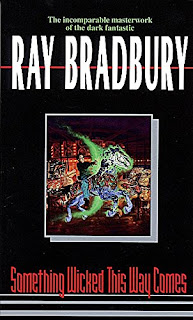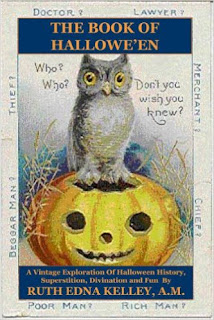Saturday, October 3, 2015
Booktoberfest
As a bibliophile and Halloweenophile (biblioweenophile?), it should come as no surprise that I have a large collection of Octoberish books. Here are a few of my favorites—a Booktoberfest, if you will. The cover illustrations are linked to Amazon.com, in case you are interested in purchasing any of them. (And before you ask, no, Amazon is not giving me a percentage, although they should certainly consider doing so.)
When I was very young, my two favorites of all of the books in my parents' collection were Comic Epitaphs from the Very Best Old Graveyards, by Henry R. Martin, and Drawn and Quartered, a paperback collection of cartoons by Charles Addams. I found these books equally frightening and fascinating, as both dealt with death. They were also funny, and they had a profound influence on my sense of humor. To this day, I prefer my comedy the same way I like my coffee: black as the inside of a witch's hat.
I found my own copy of Comic Epitaphs over twenty years ago in a little gift shop in North Tonawanda, New York. It is now out of print, but you can get a used copy through Amazon for as little as ten cents. That seems a ridiculously low price for such comedy gold as: "UNDERNEATH THIS STONE LIES POOR JOHN ROUND: LOST AT SEA AND NEVER FOUND."
I don't have Drawn and Quartered, but I do have several collections of Charles Addams cartoons, including The World of Charles Addams, a huge volume containing hundreds of his best. Here's one of my favorites:
I have a truly horrible book collection—that is to say, I have a truly large collection of books in the horror genre. I began collecting them when I was in grade school. Among the first were two anthologies by Stephen Sutton: Tales to Tremble By and its sequel, surprisingly titled More Tales to Tremble By. These cheap, hardcover "Whitman Classics" were considered children's books, although their contents—frightening tales by the likes of Charles Dickens, Bram Stoker, Saki, August Derleth, and M.R. James—were anything but childish. Both volumes are out of print, but they can still be purchased second-hand through Amazon. The covers alone are enough to give you nightmares.
The author I most associate with Halloween is Ray Bradbury. People think of him as a science fiction writer and yes, he did write stories about rockets and Martians. However, he wrote just as many stories about "things that go bump in the night" (including The October Game, one of the most horrifying short stories I have ever read). Two of his books that are especially evocative of October in general and Halloween in particular are Something Wicked This Way Comes and The Halloween Tree. Both, coincidentally, started out as screenplays, then became books, and finally became screenplays again.
Something Wicked This Way Comes was supposed to be a movie directed by Ray Bradbury's friend Gene Kelly (yes, that Gene Kelly). When none of the studios wanted to make it, Bradbury turned it into a book instead. It's one of those books that grabs hold of you the first time you read it, demands to be reread, and each time you get more out of it. When I was young, I identified with Will Halloway, who is scared to death of growing up. Now I identify with Will's father, who is just plain scared of death. But in the end he comes to a realization: "Is Death important? No. Everything that happens before Death is what counts." Something Wicked This Way Comes was finally made into a movie by Disney in 1983.
The story goes that when Ray Bradbury and his daughters watched the Charles Schulz classic, It's the Great Pumpkin, Charlie Brown, they were greatly disappointed that there was no Great Pumpkin in it. Ray decided he could do better. He talked to his friend Chuck Jones, and the two of them started work on their own animated film, The Halloween Tree, at MGM Studios. Unfortunately, MGM decided to shut down its animation unit, and that was the end of the project. In 1972, Ray published it as a book, and it instantly became a Halloween classic. In 1993, The Halloween Tree was finally made into an Emmy award-winning animated film by Hanna-Barbera, featuring Leonard Nimoy as Moundshroud and narrated by Mr. Bradbury himself.
Finally, if you're looking for a book on the history of Halloween, just this week I came across this little gem: The Book of Halloween, by Ruth Edna Kelley. The book begins with the Celts and ends with contemporary Halloween traditions. By contemporary, I mean 1919; this book is old. It's only ninety-nine cents in the Kindle store, but because it's in the public domain, you can also download it from Project Gutenberg for free. There are several versions. If you buy it from Amazon make sure you get the one with the owl and jack-o-lantern on the cover; it includes illustrations.
Happy Booktober!
Subscribe to:
Post Comments (Atom)







No comments:
Post a Comment